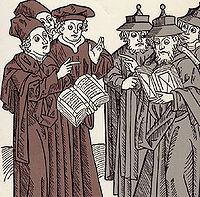
Photo from wikipedia
In the aftermath of the Fourth Crusade Byzantines and Latins engaged in numerous instances of dialogue and negotiation intended to unite the Greek and Roman Churches. The meeting between four… Click to show full abstract
In the aftermath of the Fourth Crusade Byzantines and Latins engaged in numerous instances of dialogue and negotiation intended to unite the Greek and Roman Churches. The meeting between four mendicant friars and Patriarch Germanos II in Nicaea and Nymphaion in 1234 is indicative of a continuous trend in Byzantine diplomacy going back to the Komnenoi emperors that used ecclesiastical debate as a mechanism for diplomatic gain. In the years after 1204, however, church-union negotiation took on new purpose, serving to solidify Byzantine identity and resistance in the face of western invaders. Although the study of dialogue and disputation is enjoying a period of renewed focus among western medievalists, the field of Byzantine Studies, with few exceptions, has confined such material to the realm of theological research, neglecting the importance of such encounters, especially in the period after the Fourth Crusade. This study sets out to address why historians of Byzantium have been apprehensive about embracing the sources that describe ecclesiastical dialogue, and show how they can inform us about diplomacy, society and identity in the Eastern Mediterranean world after 1204.
Journal Title: Medieval Encounters
Year Published: 2018
Link to full text (if available)
Share on Social Media: Sign Up to like & get
recommendations!